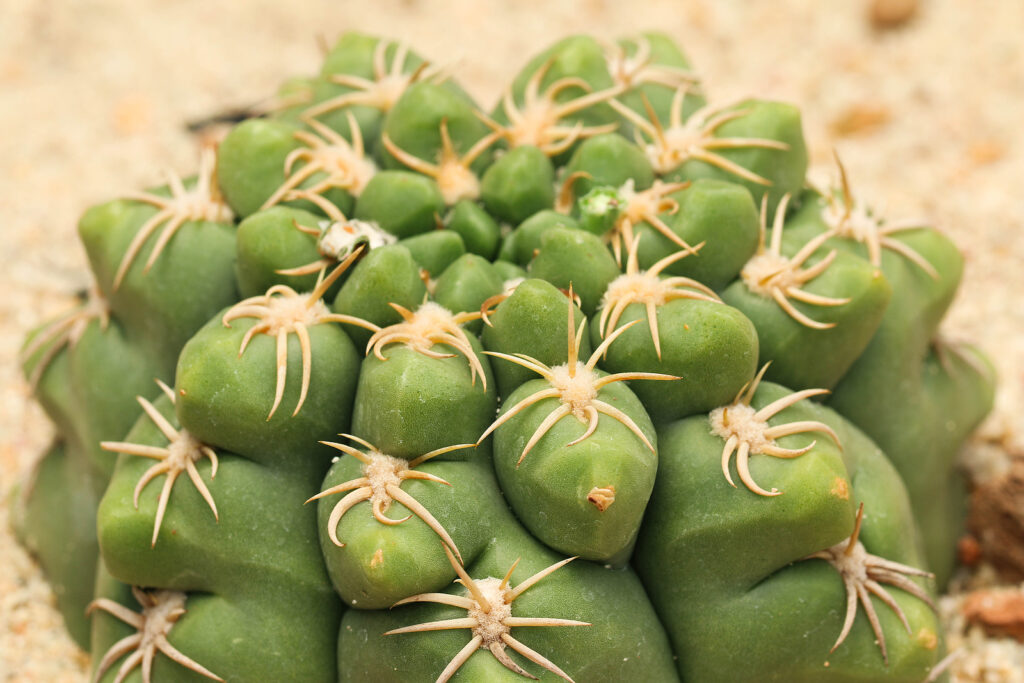Gymnocalycium–commonly called chin cactus–are globular cacti that have chinlike protrusions right below each areole and spine cluster. Gymnocalycium is a large genus of about 40 species that ranges from dwarfs less than 2 inches across to others that are 8 inches tall and wide.
Gymnocalycium flowers at a young age. Daisylike flowers range from white to pale yellow and pink. Flowers appear in spring or fall. Smooth naked flower buds precede the blossoms.
Most Gymnocalycium needs protection from direct sunlight. If kept completely dry they will tolerate cool winter temperatures. They are among the easiest, most interesting cacti to cultivate.
Get to know Gymnocalycium
- Plant type: Cactus, chin cactus
- Hardiness temperature: Hardy to 35℉ (1.7℃)
- Optimal growing temperature: day, 68° to 72°F (20° to 22°C); night, 50° to 55°F (10° to 13°C).
- Shape and size: Globular cacti, occasionally found growing in clusters; sizes range from 1.5 inches (4cm) across to 8 inches (20cm) tall and wide
- Flowers: Flowers at early age; flowers last for several days; flower colos range from white to pale yellow to pink
- Bloom time: Late spring
- Common name: Chin cactus, spider cactus
- Genus name: Gymnocalycium
- Family name: Cactaceae
- Origin: South America, Argentina, Brazil

Planting Gymnocalycium
- Plant Gymnocalycium in sandy loam or a cactus mix that is well drained.
- Protect Gymocalycium from direct sunlight; indoors grow in bright light.
- Indoors plant Gymnocalycium in bright light, at least 4 hours direct sun daily, from southern or western exposure. Air circulation is important.
How to water and feed Gymnocalycium
- Give Gymnocalycium regular water duirng the growing season. Allow the soil to dry between waterings. Avoid overwatering.
- Keep humidity at 30% to 45%.
- Feed Gymnocalycium once a year, in spring, with high-potassium fertilizer.
Gymnocalycium care
- Pot-on Gymnocalycium when pot space is overcrowded.
- Check for aphids, mealybugs, spider mites, scale. Also be alert for fungus disease.
- Let Gymnocalycium rest during winter. Place plant in a cool location with 5 hours of light. Water just enough to keep the plant from shriveling.
- Propagate Gymnocalycium by offsets or seeds.
Gymnocalycium species to grow
- Gymnocalycium baldianum. Measures 3 inches (8 cm) across; dark green stem has gray spines; burgundyflowers measure up to 2 inches (5 cm) across.
- G. bruchii. Grows in large dense clumps of bluish stems covered with bristly, white curved spines; flowers are rose-colored to white, often darker inside.
- G. damsii. Related to G. schickendantzi; has all-white flowers and needlelike spines.
- G. denudatum (spider cactus). Grows to 6 inches (15 cm) in diamet; stems are shiny green and bulging; spreading, appressed, yellow spines give plant a spider appearance; 3 inch (8 cm) wide flowers are pale rose or white and appear freely and profusely; needs some shade during bright, warm summer months.
- G. lafaldense. See G. brunchii
- G mihanovichii (plaid cactus). Small, gray green globe with crisscrossed ribs and curved spines; pale yellow to chartreuse flowers appears in profusion even on young plants.
- G. m. friedrichli. Dark green stem with dark markings; ‘RubyBall’ is pure red; ‘Blondie’ is yellow.
- G. multiflorum. Bright green cacti has 10-15 irregular, strongly, tubercled ribs; slender, awl-shaped yellow spines; flowers are white, pinkish, or light brown; when grafted to Hylocereus, resultant plant is known as moon cactus. . Variety ‘Albispina’ has appressed, white spines.
- G. oenanthemum. Pale red, 2-inch-long flowers; awl-shaped, recurved spines are light, tipped with darker reddish brown.
- G. quehilanum (dwarf chin cactus). Has a 6 inch (15 cm) wide, blue-green flattened globe; bears large white, red-throated flowers.
- G. saglione (giant chin cactus). Largest of the genus, often reaching 1 foot wide; long, thick, recurved spines are usually dark, may be reddish yellow on younger specimens; pink or flesh- colored flowers appear at crown
- G. schinckendantzli (white chin cactus). Flattened, reddish spines turn gray with age; flowers are white to pink, sometimes yellow.















